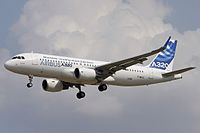
Photo from wikipedia
Abstract This paper demonstrates the noise reduction potential from modified final approach and landing procedures of commercial aircraft. A conventional trajectory is compared with a steep approach with a 4.5-degree… Click to show full abstract
Abstract This paper demonstrates the noise reduction potential from modified final approach and landing procedures of commercial aircraft. A conventional trajectory is compared with a steep approach with a 4.5-degree glide slope (first option), and with a displaced landing, wherein an aircraft approaching with a 3-degree slope is allowed to land with a second threshold (second option). The reference airplane is the Airbus A320-211. Examples of noise footprints are shown for generic cases of constant ground impedance. It is shown that a noise reduction of −1 EPNL reduction is possible with a 450 m landing displacement or with a 3.5 degree glide slope. Noise reduction occurs below the flight track and moderate lateral distances. It is also shown that at larger lateral distances, 200 m or above, the noise level increases compared to the reference case. The ground model has been extended to include variable impedance and actual airfields. Finally, it is shown that an Embraer E195 model landing on a steep trajectory has a reduced noise almost everywhere in a selected region around the airfield.
Journal Title: Aerospace Science and Technology
Year Published: 2017
Link to full text (if available)
Share on Social Media: Sign Up to like & get
recommendations!